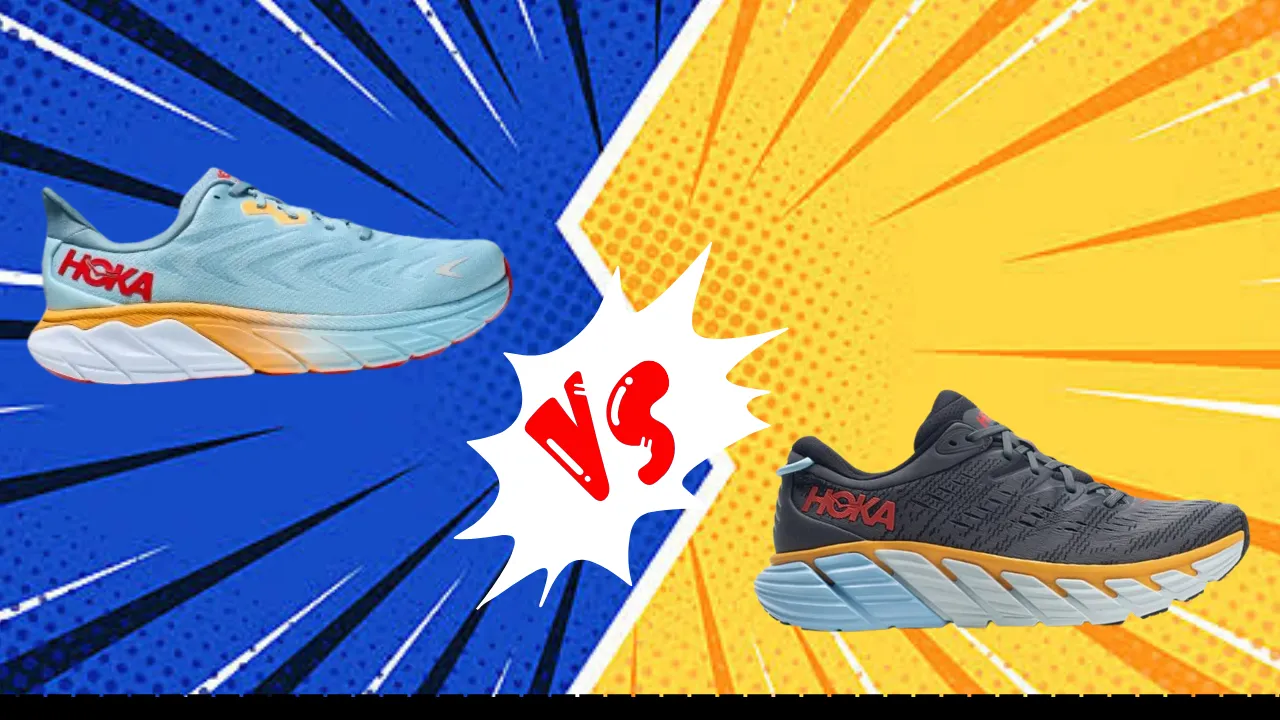If you’re looking for a stability running shoe from Hoka One One, you can’t go wrong with either the Arahi 6 or the Gaviota 4. Both shoes provide moderate-to-maximum support and cushioning to keep your feet comfortable on the run. Read on for a detailed comparison of these two popular Hoka models to help you decide which is the better option for your needs.
Similarities And Differences Between Arahi 6 And Gaviota 4:
| Feature | Hoka Arahi 6 | Hoka Gaviota 4 |
|---|---|---|
| Launched In | 2022 | 2018 |
| Stability | Moderate | Maximum |
| Flexibility | Moderate | Moderate |
| Sizing | Men’s 7-13, Women’s 5-11 | Men’s 7-13, Women’s 5-11 |
| Weight | 10.3 oz (men’s), 8.8 oz (women’s) | 11.4 oz (men’s), 9.8 oz (women’s) |
| Cushion | Moderate | Maximum |
| Outsole | Durable rubber | Durable rubber |
| Midsole | CMEVA foam, J-Frame stability technology | CMEVA foam, J-Frame stability technology |
| Upper | Engineered mesh | Engineered mesh |
| Retail Price | $140 | $153 |
Features Comparison
Materials
The Arahi 6 and Gaviota 4 both use durable rubber in the outsole. The engineered mesh upper provides a secure and breathable fit in both shoes. Inside, they contain CMEVA foam in the midsole, which is soft and responsive. The key difference lies in the stability technology.


The Arahi 6 uses a J-Frame in the midsole, while the Gaviota 4 has both a J-Frame and an H-Frame fit. These frames provide structured support to prevent overpronation during the gait cycle. Overall, the materials are similar between both shoes, with the Gaviota 4 offering additional stability features.
Durability
In terms of durability, both the Arahi 6 and Gaviota 4 are built to last many miles on the road or trail. The rubber outsole and engineered mesh upper are designed for resilience, protecting against wear and tear.
The CMEVA foam midsole also maintains its cushioning and bounce over time. Some reviewers have noticed the outsole rubber wearing down faster on the Gaviota 4, likely due to the added weight of the shoe.
However, both models should provide at least 300-500 miles of use before signs of breakdown. The J-Frame and H-Frame technologies are built to maintain their stability too. Overall, the Arahi 6 may have a slight durability edge over the Gaviota 4, but both shoes are made to stand up to repeated pounding.
Fit
The Arahi 6 and Gaviota 4 offer a secure midfoot wrap and responsive toe box area. The engineered mesh upper molds comfortably to the foot. One notable difference is the Gaviota 4’s added H-Frame fit technology, providing a slightly more snug midfoot hold for stability.


However, some reviewers have pointed out that it causes pressure points or cramped toes due to the narrower fit. The Arahi 6 offers a more relaxed fit through the midfoot that accommodates different foot shapes. Both shoes run true to size.
There is ample room in the toe box of each model to allow natural toe splaying. The Arahi 6 may have a slight edge in offering versatile width options that adapt better to narrow or wide feet. But the Gaviota 4 provides an incredibly locked-in fit at the midfoot, which some runners prefer.
Stability
The Arahi 6 offers moderate stability from its J-Frame technology, making it ideal for runners who need some pronation control in their shoes. The dual-density midsole provides structured cushioning without being overly rigid or restrictive.
In contrast, the Gaviota 4 maximizes stability through both J-Frame and H-Frame fit. This creates a very controlled ride for severe overpronators, providing maximum motion control.
The snug midfoot fit and firm cushioning prevent rolling or sliding inside the shoe. If you only need mild stability features, the Arahi 6 strikes the right balance without impacting flexibility.
But for those requiring the most stability, the Gaviota 4 is up to the task. Just be aware the dense midsole and H-Frame can feel very rigid at first.
Cushioning
With a 5mm drop, both shoes offer heel and forefoot cushioning. The Arahi 6 has a moderate cushioning level, providing responsive shock absorption and energy return during toe-offs.
The firm CMEVA foam and rocker design make it highly responsive while running. In the Gaviota 4, the max cushioning lives up to its name. The thicker CMEVA midsole and plush insole create a very soft, pillowy ride.
This gives it superior impact protection on longer, slower runs when you need that extra cushioning. However, the dense foam is less bouncy compared to the Arahi 6. If you prefer a firm, responsive ride, the Arahi 6 is the better pick. But the Gaviota 4 envelops your foot in plush comfort over high mileage.
Value
At its retail price of $140, the Arahi 6 provides great value given its versatile stability, durable construction, and responsive ride. Similarly, the Gaviota 4 is well worth its $153 price tag if you require maximum stability and cushioning.
Paying up gets you those advanced H-Frame features and extra thick midsole. So weigh your needs and budget when deciding if the price difference is justified. For runners needing only moderate stability, the Arahi 6 gives you reliable support and performance without overpaying.
But severe overpronators who log high weekly miles would benefit from the Gaviota 4’s superior motion control and impact protection. Just make sure to try it on in-store first to ensure the narrow fit works for your foot. Overall, both models deliver excellent value.
Performance Comparison
Walking
The Arahi 6 and Gaviota 4 both perform well for walking and casual wear. The cushioned midsoles and roomy toe boxes provide comfortable footing during long walks.
The Arahi 6 may feel slightly more agile thanks to its moderate stability features. In contrast, the very structured Gaviota 4 can feel somewhat stiff for just walking around. However, the plush cushioning absorbs impact nicely.
Those needing more support while walking longer distances would appreciate the Gaviota 4. But overall, both shoes allow natural foot motion during walking while keeping you well-cushioned.
Running
For running, the Arahi 6 offers a responsive, moderately stable ride that suits daily training. The rockered design encourages smooth transitions and toe-offs. The cushioning provides good shock absorption without feeling overly soft.
Meanwhile, the Gaviota 4 is made for recovery jogs and long runs at easy paces. The maximal cushioning softens impact significantly, though the dense foam is less energetic. The structured stability technologies also provide control but reduce ground feel sensation.
At faster paces, the Arahi 6 is the more agile, smoother shoe while still supplying stability. The Gaviota 4 shines for lengthy mileage due to its superior comfort and support. Choose the Arahi 6 if you want a versatile stability trainer, and the Gaviota 4 for extra slow miles.
Plantar Fasciitis
For plantar fasciitis, the Gaviota 4 may have a slight edge due to its thicker, softer cushioning through the heel. This provides excellent shock absorption and minimizes pressure on the sensitive plantar fascia tissue.
However, the Arahi 6 also supplies ample heel cushioning and a rockered design to alleviate strain during push-offs. So runners with minor plantar fasciitis could likely train comfortably in either model.
Those with more aggravated symptoms would benefit most from the Gaviota 4’s plush cushioning, though it sacrifices some responsiveness.
Standing All Day
The Arahi 6 and Gaviota 4 both make supportive options for occupations that require standing all day, like nursing. The cushioned midsoles alleviate foot fatigue versus regular shoes.
Between the two, the Gaviota 4 may have an advantage thanks to its softer density foam that absorbs shock for hours on end. The snug midfoot fit also enhances stability on your feet over a long shift.
However, some may find the Arahi 6 more comfortable long-term since it allows for more natural foot motion when stationary. Overall, both models are cushioned and stable enough for prolonged standing.
Final Verdict
In the end, deciding between the Hoka Arahi 6 and Gaviota 4 comes down to your stability and cushioning preferences.
If you want moderately enhanced pronation control in a lightweight, responsive package, go for the Arahi 6. But runners requiring maximum stability and softness underfoot should choose the Gaviota 4.
Both shoes deliver lasting comfort and support mile after mile. While the Arahi 6 has wider appeal as a daily trainer, overpronators will benefit most from the Gaviota 4’s advanced motion control features. Try them back-to-back to determine which Hoka stability shoe meshes with your foot biomechanics and feel preferences.

